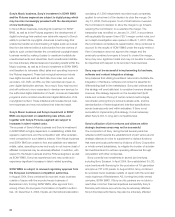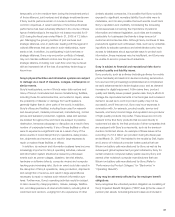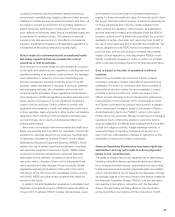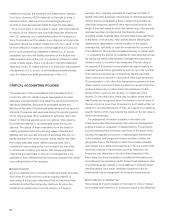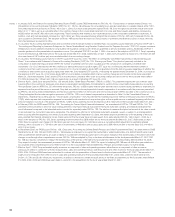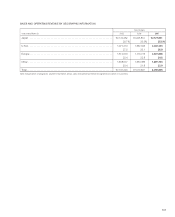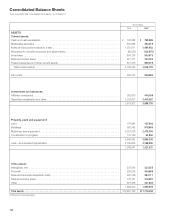Sony 2007 Annual Report Download - page 96
Download and view the complete annual report
Please find page 96 of the 2007 Sony annual report below. You can navigate through the pages in the report by either clicking on the pages listed below, or by using the keyword search tool below to find specific information within the annual report.
93
past several years and will result in an increase in pension costs
as they are recognized.
Sony recorded a minimum pension liability adjustment for the
unfunded accumulated benefit obligation for Japanese pension
plans of 35.8 billion yen as of March 31, 2006. FAS No. 158 was
adopted by Sony in the financial statements for the year ended
March 31, 2007. As a result, Sony recorded a pension liability
adjustment for the prior service cost, net actuarial loss and
obligation existing at transition for Japanese pension plans of
73.5 billion yen as of March 31, 2007. Both adjustments were
established by a charge to stockholders’ equity, resulting in no
impact to the accompanying consolidated statements of
income. Refer to Note 14 of Notes to Consolidated Financial
Statements for more information regarding Sony’s pension and
severance plans.
The following table illustrates the effect of changes in the
discount rate and the expected return on pension plan assets,
while holding all other assumptions constant, for Japanese
pension plans as of March 31, 2007.
CHANGE IN ASSUMPTION
Yen in billions
Pre-tax Pension Equity
PBO costs (net of tax)
25 basis point increase /
decrease in discount rate . . .
–/+ 24.9 –/+2.0 +/–1.2
25 basis point increase /
decrease in expected
return on assets. . . . . . . . . .
— –/+ 1.3 +/–0.8
■STOCK-BASED COMPENSATION
Sony accounts for stock-based compensation using the fair
value-based method. The fair value is measured on the date of
grant using the Black-Scholes option-pricing model. Sony
estimates the forfeiture rate based on its historical experience for
the stock acquisition rights plans, and recognizes this compen-
sation expense, net of an estimated forfeiture rate, only for the
stock acquisition rights expected to vest over the requisite
service period. The expense is mainly included in selling, general
and administrative expenses.
The Black-Scholes option-pricing model requires various
highly judgmental assumptions including expected stock price
volatility and the expected life of each award. In addition,
judgment is also required to estimate the expected forfeiture rate
and recognize expense only for those rights expected to vest.
Management believes that these estimates are reasonable;
however, if actual results differ significantly from these estimates,
stock-based compensation expense may differ materially in the
future from that recorded in the current period.
■DEFERRED TAX ASSET VALUATION
Sony records a valuation allowance to reduce the deferred tax
assets to an amount that management believes is more likely
than not to be realized. In establishing the appropriate valuation
allowance for deferred tax assets (including deferred tax assets
on tax loss carry-forwards), all available evidence, both positive
and negative, is considered. Information on historical results is
supplemented by all currently available information on future
years, because realization of deferred tax assets is dependent on
whether each tax-filing unit generates sufficient taxable income.
The estimates and assumptions used in determining future tax-
able income are consistent with those used in Sony’s approved
forecasts of future operations. Although realization is not assured,
management believes it is more likely than not that all of the
deferred tax assets, less valuation allowance, will be realized.
SCE and SCEA have recorded cumulative losses in recent
years primarily due to the sale of the PS3 at a price lower than
production cost during the introductory period, the recording of
other charges in association with the preparation for the launch
of the PS3 platform and a write-down for semiconductor
components used in the PS3. However, Sony expects to
establish the same successful business model with the PS3
that it achieved with the PS2, which has sold over 100 million
units. Taxable income is expected to increase during the tax
carryforward period due to the rapid reduction in hardware
production costs and an enhanced lineup of software titles in
the PS3 business. Accordingly, both companies expect to
recover these losses within the next five years.
Given sufficiently strong evidence to support the conclusion
that a valuation allowance is not necessary, Sony has decided
not to record a valuation allowance for SCE and SCEA’s
deferred tax assets.
■FILM ACCOUNTING
An aspect of film accounting that requires the exercise of
judgment relates to the process of estimating the total revenues
to be received throughout a film’s life cycle. Such estimate of
a film’s ultimate revenue is important for two reasons. First,
while a film is being produced and the related costs are being
capitalized, it is necessary for management to estimate the
ultimate revenue, less additional costs to be incurred, including
exploitation costs which are expensed as incurred, in order to
determine whether the value of a film has been impaired and
thus requires an immediate write off of unrecoverable film costs.
Second, the amount of film costs recognized as cost of sales for
a given film as it is exhibited in various markets throughout its life
cycle is based upon the proportion that current period actual
revenues bear to the estimated ultimate total revenues.





